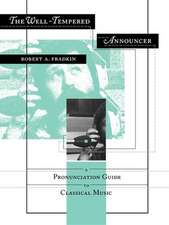The Beethoven Sonatas and the Creative Experience
Autor Kenneth O. Drakeen Limba Engleză Paperback – 21 apr 1994
Juxtaposing sonatas of like characteristics, regardless of where they fall in Beethoven's oeuvre, Drake places the very early Op. 2 No. 2 and the monumental Op. 101 in the chapter entitled Line and Space." Under the heading "Descriptive Music," he discusses Op. 81a and Op. 13" under "Motivic Development," Op. 2 No. 1, Op. 57, and Op. 110 and under "Movement as Energized Colour," Op. 53. The chapter entitled "Quasi una Fantasia" encompasses not only the Sonata Op. 27 No. 2, to which Beethoven gave that title, but also Sonatas Op. 26 and Op. 27 No. 1.
Drake pursues the emotional and interpretative implications of such elements as rhythm, dynamics, slurs, harmonic effects, and melodic development. He provides hundreds of musical examples and points out the specific measures in which Beethoven so skilfully employed these compositional devices.
Kenneth Drake regards the Beethoven sonatas as products of an inner necessity that pianists share with the composer. He encourages musicians to exercise intuition and independence of thought in studying the "32" and to seek no just performance skills but logical conclusions about ideas and relationships within the score.
Preț: 204.30 lei
Nou
Puncte Express: 306
Preț estimativ în valută:
39.09€ • 42.60$ • 32.94£
39.09€ • 42.60$ • 32.94£
Carte tipărită la comandă
Livrare economică 23 aprilie-07 mai
Preluare comenzi: 021 569.72.76
Specificații
ISBN-13: 9780253213822
ISBN-10: 0253213827
Pagini: 336
Dimensiuni: 155 x 233 x 22 mm
Greutate: 0.48 kg
Editura: MH – Indiana University Press
ISBN-10: 0253213827
Pagini: 336
Dimensiuni: 155 x 233 x 22 mm
Greutate: 0.48 kg
Editura: MH – Indiana University Press
Cuprins
Preface
1. The First Raptus, and All Subsequent Ones
*The Sounds of Involvement
2. Technique as Touch
3. Tempo and the Pacing of Musical Ideas
4. Dynamic Nuance and Musical Line
5. The Role of Silence
6. Sound as Color
*The Sonatas
7. Descriptive Music: Op.81a, Op.13
8. Motivic Development: Op.2 No.1, Op.57, Op.110
9. Quasi una Fantasia: Op.27 Nos.1 and 2, Op.26
10. Line and Space: Op. 2 No.2, Op 101
11. Movement as Energized Colour: Op.53
12. The Moment of Creation: Op.28, Op.31 Nos.2 and 3
13. Facing Two Directions: Op.49 Nos.1 and 2, Op.54, Op. 78, Op. 90
14. The Enjoyment of Fluency: Op.10 Nos.2 and 3, Op. 14 No. 2, Op.22, Op.31 No.1, Op.79
15. The Cosmopolitan Impostor: Op.2 No.3, Op.14 No.1
16. Embracing the Dachstein: Op. 7, Op. 106
17. A Higher Revelation: Op.10 No.1, Op.109, Op.111
18. The Witness Tree
*Notes
1. The First Raptus, and All Subsequent Ones
*The Sounds of Involvement
2. Technique as Touch
3. Tempo and the Pacing of Musical Ideas
4. Dynamic Nuance and Musical Line
5. The Role of Silence
6. Sound as Color
*The Sonatas
7. Descriptive Music: Op.81a, Op.13
8. Motivic Development: Op.2 No.1, Op.57, Op.110
9. Quasi una Fantasia: Op.27 Nos.1 and 2, Op.26
10. Line and Space: Op. 2 No.2, Op 101
11. Movement as Energized Colour: Op.53
12. The Moment of Creation: Op.28, Op.31 Nos.2 and 3
13. Facing Two Directions: Op.49 Nos.1 and 2, Op.54, Op. 78, Op. 90
14. The Enjoyment of Fluency: Op.10 Nos.2 and 3, Op. 14 No. 2, Op.22, Op.31 No.1, Op.79
15. The Cosmopolitan Impostor: Op.2 No.3, Op.14 No.1
16. Embracing the Dachstein: Op. 7, Op. 106
17. A Higher Revelation: Op.10 No.1, Op.109, Op.111
18. The Witness Tree
*Notes
Recenzii
" . . . one of the most interesting, useful and even exciting books on the process of musical creation." --American Music Teacher
" . . . noteworthy contribution . . . with plenty of insight into interpretation . . . remarkable as an insider's account of the works in an individual perspective." --European Music Teacher
". . . one of the most interesting, useful and even exciting books on the process of musical creation." --Marilyn Neeley, American Music Teacher
"This book is a highly worthwhile addition for every serious pianist's library and to the scholarship on Beethoven. It is lavishly illustrated with examples from the scores." --William Race, Notes
"In [this book's] blend of pianistic, analytical and aesthetic issues, the author breaks new ground, encouraging a more holistic interpretative approach." --Malcolm Miller, European Music Teacher
" . . . noteworthy contribution . . . with plenty of insight into interpretation . . . remarkable as an insider's account of the works in an individual perspective." --European Music Teacher
". . . one of the most interesting, useful and even exciting books on the process of musical creation." --Marilyn Neeley, American Music Teacher
"This book is a highly worthwhile addition for every serious pianist's library and to the scholarship on Beethoven. It is lavishly illustrated with examples from the scores." --William Race, Notes
"In [this book's] blend of pianistic, analytical and aesthetic issues, the author breaks new ground, encouraging a more holistic interpretative approach." --Malcolm Miller, European Music Teacher
Notă biografică
Textul de pe ultima copertă
Instead of following the traditional chronological order in studying the Beethoven piano sonatas, Kenneth Drake places them in categories that reflect certain qualities of the music. Approaching the sonatas as an interpreter's search for meaning, he begins with the Classic composers' expressive treatment of the keyboard - such as touches, articulation, line, color, silence, and the pacing of musical ideas. He then analyzes individual Beethoven sonatas, exploring such qualities as motivic development, color, philosophic overtones, and technical facility. Juxtaposing sonatas of like characteristics, regardless of where they fall in Beethoven's oeuvre, Drake places the very early Op. 2 No. 2 and the monumental Op. 101 in the chapter entitled ""Line and Space."" Under the heading ""Descriptive Music,"" he discusses Op. 81a and Op 13; under ""Motivic Development,"" Op. 2 No. 1, Op. 57, and Op. 110; and under ""Movement as Energized Color,"" Op. 53. The ""Quasi una Fantasia"" encompasses not only the Sonata Op. 27 No. 2, to which Beethoven gave that title, but also Sonatas Op. 26 and, Op. 27 No. 1. Drake pursues the emotional and interpretive implications of such elements as rhythm, dynamics, slurs, harmonic effects, and melodic development. He provides hundreds of musical examples and points out the specific measures in which Beethoven so skillfully employed these compositional devices. Kenneth Drake regards the Beethoven sonatas as products of an inner necessity that pianists share with the composer. He encourages musicians to exercise intuition and independence of thought in studying the ""32"" and to seek not just performance skills but logical conclusions about ideas and relationships within thescore.
Descriere
A revealing exploration of all 32 of Beethoven's sonatas.



















